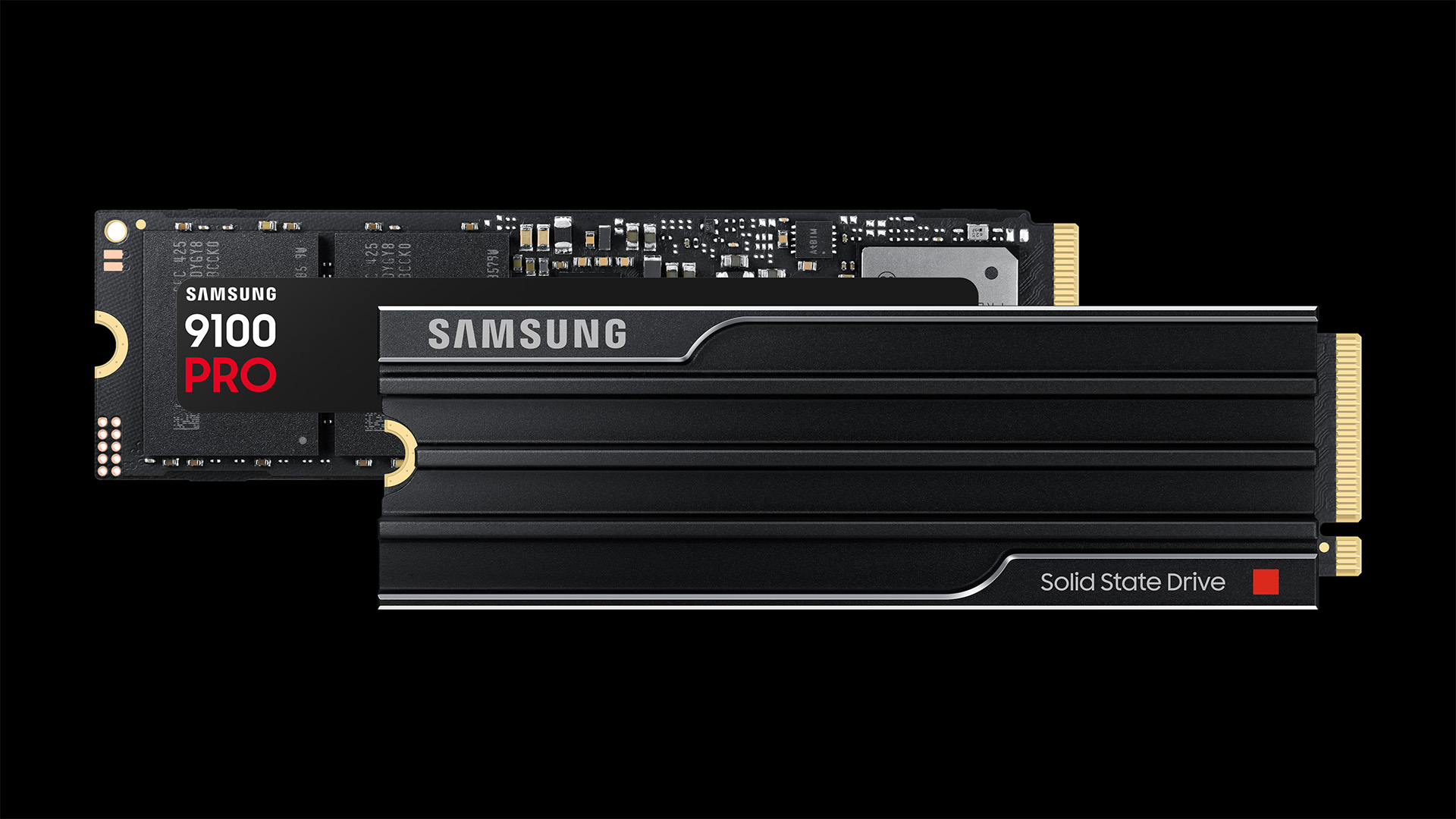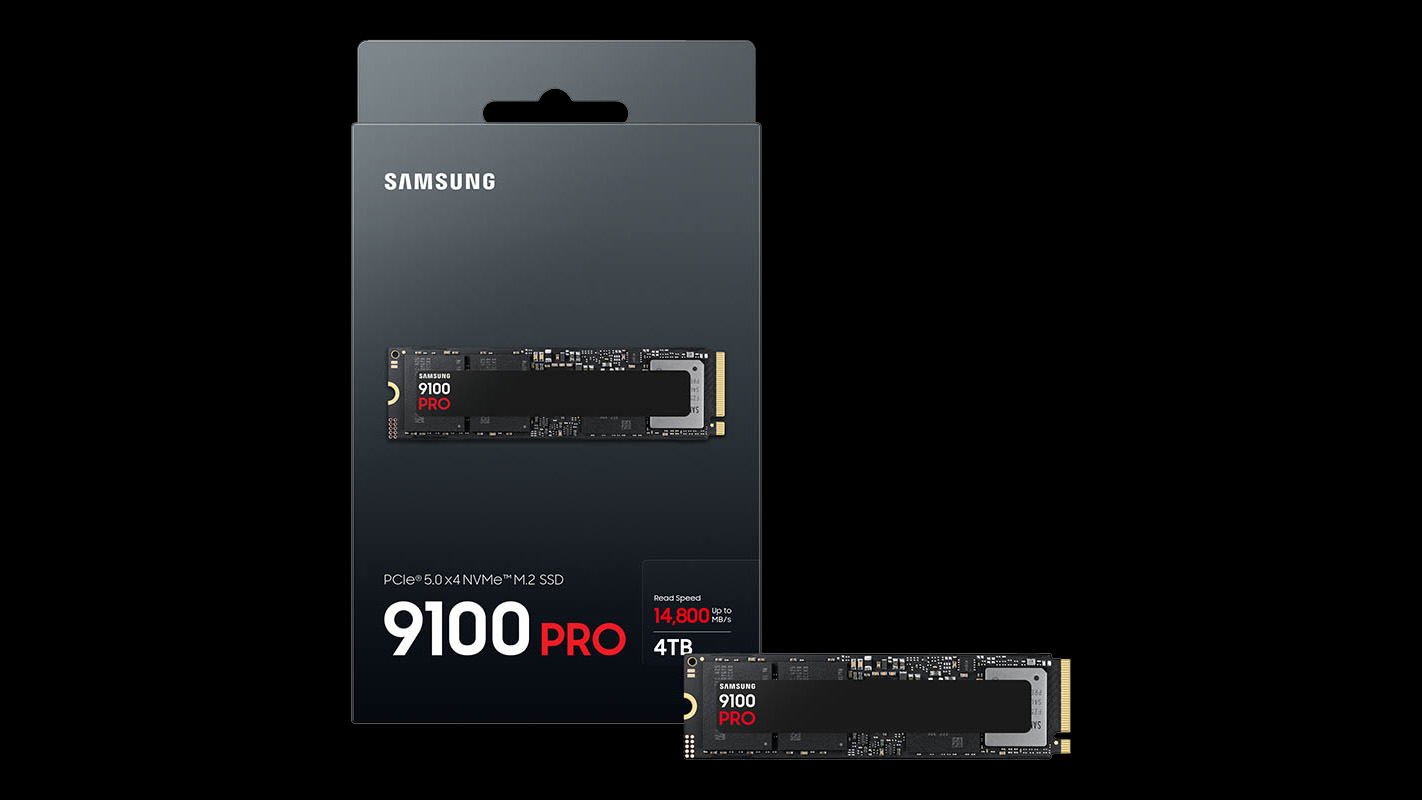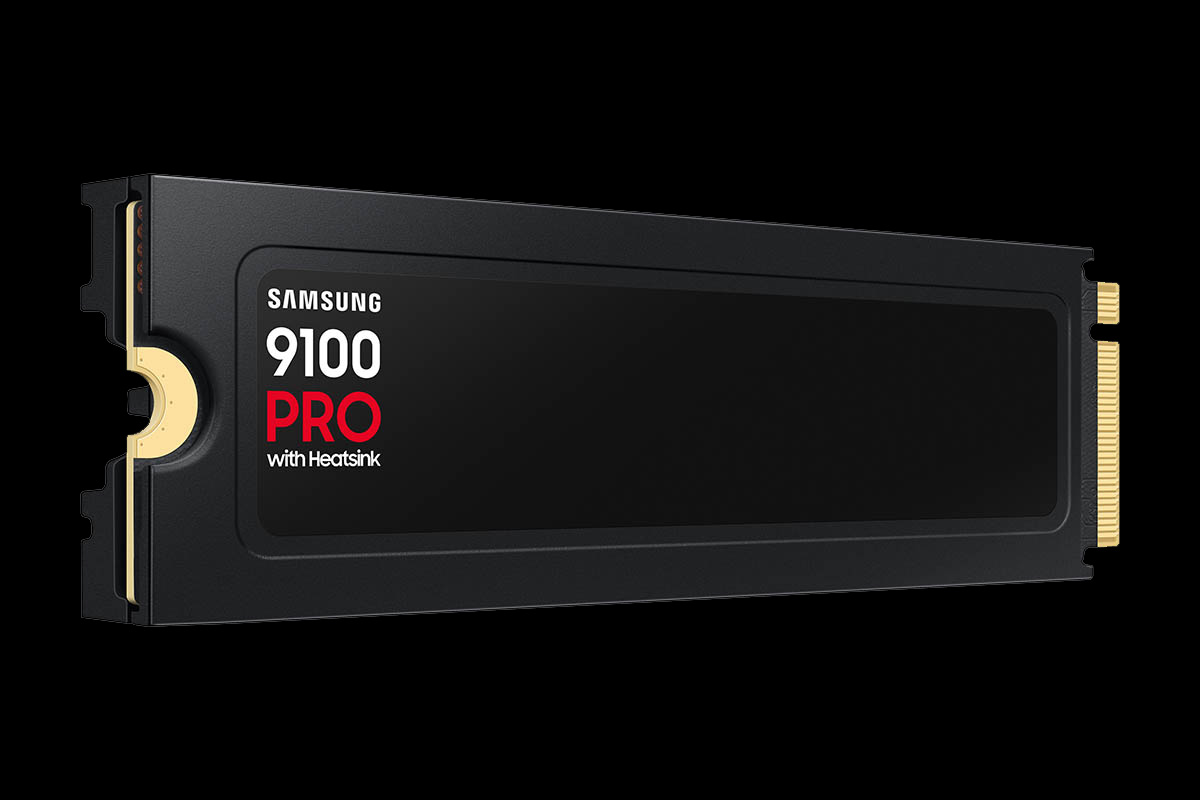Samsung's 9100 Pro SSD boasts 14.8 GB/s read speeds, making it the world's fastest consumer drive
It's the company's first true PCIe 5.0 drive, boasting high performance at just 9W of power use.

Samsung is finally getting into the high performance PCIe 5.0 storage game, two years after the first PCIe 5.0 SSDs arrived. The Korean phone and storage maker unveiled its first "true" PCIe 5.0 SSD, the 9100 Pro, which delivers full PCIe 5.0 speeds. Samsung's new M.2 NVMe SSD is capable of read speeds of up to 14.8 GB/s. Pricing will start at $199.99, and the drive comes with a 5-year warranty.
The new drive is built on a revised version of Samsung's TLC V8 V-NAND flash and utilizes the company's homebrewed "Presto" SSD controller. The main selling point of the drive is its full PCIe 5.0 interface, packing four lanes and sporting the NVMe 2.0 protocol. Samsung's previous 990 EVO and 990 EVO Plus drives could operate in either PCIe 4.0 x4 mode, or PCIe 5.0 x2 mode, so they're only half as fast in terms of maximum bandwidth as "true" 5.0 x4 drives.


Samsung offers the 9100 Pro in four configurations: a 1TB variant with 1GB of cache, a 2TB model with 2GB of cache, a 4TB model with 4GB of cache, and an 8TB model with 8GB of cache. The 1TB and 2TB variants are rated at sequential read speeds of up to 14,700 MB/s (14.7 GB/s) and sequential write speeds of 13,300 MB/s, though the 2TB gets a 100MB/s upgrade to 13,400 MB/s. The 4TB and 8TB models are the fastest, sporting sequential read speeds of up to 14,800 MB/s and write speeds of up to 13,400 MB/s.
Random read speeds on the 1TB and 2TB models are rated at 1,850K IOPS and 2,600K IOPS on random write speeds. The 4TB and 8TB models get a boost to 2,200K and 2,600K IOPS on the random read and write speed performance, respectively. Here's the full specifications rundown.
| Row 0 - Cell 0 | 1TB | 2TB | 4TB | 8TB |
Cache | 1GB LPPDR4X | 2GB LPPDR4X | 4GB LPPDR4X | 8GB LPPDR4X |
Sequential Read/Write | 14,700 / 13,300 MB/s | 14,700 / 13,400 MB/s | 14,800 / 13,400 MB/s | 14,800 / 13,400 MB/s |
Random Read/Write | 1,850K / 2,600K IOPS, QD32 | 1,850K / 2,600K IOPS, QD32 | 2,200K / 2,600K IOPS, QD32 | 2,200K / 2,600K IOPS, QD32 |
Power (Read/Write) | 7.6W / 7.2W | 8.1W / 7.9W | 9.0W / 8.2W | TBD |
Device Sleep (L1.2) | 4.0mW / 3.3mW | 4.8mW / 4.0mW | 6.5mW / 5.7mW | TBD |
Intelligent TurboWrite 2.0 | 114GB | 226GB | 442GB | TBD |
Total Bytes Written | 600 TBW | 1,200 TBW | 2,400 TBW | 4,800 TBW |
The 9100 Pro supports several data encryption protocols featuring Class 0 (AES 256), TCG/Opal v2.0, and MS eDrive (IEEE1667). Pricing goes up as the capacity increases, though not linearly. The 1TB model costs $199.99, the 2TB will set you back $299.99, and the 4TB is 'only' $549.99. Technically, that means the 4TB drive has the best price per TB, at $137.50 per TB, comparted to $150 per TB on the 2TB and $200 on the 1TB model. The 8TB drive and its associated pricing will be released later in the second half of 2025.
The Samsung 9100 Pro represents the company's first PCIe 5.0 SSD with speeds well beyond what the Best SSDs using PCIe 4.0 can achieve. Technically, the Samsung 990 EVO was the first PCIe 5.0 SSD the company released, but that drive was not geared toward performance. It featured four PCIe lanes, but used a switch to run just two lanes in PCIe 5.0 mode, limiting its performance to the same level as PCIe 4.0 x4 SSDs.
With speeds of 14.8GB/s, the 9100 Pro barely outperforms the world's fastest consumer-focused PCIe 5.0 SSD right now, the Crucial T705 (which features up to 14.5 GB/s of performance). You'll have to wait for our review of the drive, but the sticker box specs, at the very least, suggest the drive will take the spot of the T705 as the fastest consumer SSD in the world. How will it fare in real-world scenarios, though? That remains to be seen.
Get Tom's Hardware's best news and in-depth reviews, straight to your inbox.

Aaron Klotz is a contributing writer for Tom’s Hardware, covering news related to computer hardware such as CPUs, and graphics cards.
-
Jame5 I would love to see a head-to-head between this and the Micron 4600, or any other new SM2508 powered drive.Reply -
bit_user @JarredWaltonGPU & @PaulAlcorn ,Reply
Can you please ask whoever reviews this to measure power consumption (active idle + under load) at PCIe 4.0 speeds, as well? I found that sadly lacking from two other PCIe 5.0 drives recently reviewed:
https://www.tomshardware.com/pc-components/ssds/addlink-g55-ssd-review/2 https://www.tomshardware.com/pc-components/ssds/corsair-mp700-elite-ssd-review/2
I don't care so much about performance at PCIe 4.0 speeds, just want to know how much less power it uses. Just running the 50 GB folder copy tests @ PCIe 4.0 (as well as 5.0, obviously) would be enough for me.
Thanks! -
bit_user Reply
That's probably due to your antivirus and it's doing per-file scanning.kaalus said:What's the point if Windows won't delete more than about 100 files per second anyway?
For games, they should be able to avoid that overhead by holding open their data files and just seeking around in them. Game loading benchmarks clearly show that some games are certainly influenced by SSD speeds.
Also, large file reads or copies depend on SSD speed. These can include things like reading AI models, loading VM images, and performing VM snapshots.
Another thing you can do is to disable antivirus for certain directories. Software developers often do this, in the area where they checkout their source code and perform builds. Otherwise, performance is too heavily impacted. -
JarredWaltonGPU Reply
I'm actually the one doing the testing, with Shane writing the reviews. I mostly don't test at slower speeds because it just takes more time. The 2230 drives are already a pain in the neck, since I test them at PCIe 3.0 plus "maximum" (4.0 in all cases so far) performance mode. I'm trying to avoid committing to doing that on any more drives. LOLbit_user said:@JarredWaltonGPU & @PaulAlcorn ,
Can you please ask whoever reviews this to measure power consumption (active idle + under load) at PCIe 4.0 speeds, as well? I found that sadly lacking from two other PCIe 5.0 drives recently reviewed:
https://www.tomshardware.com/pc-components/ssds/addlink-g55-ssd-review/2https://www.tomshardware.com/pc-components/ssds/corsair-mp700-elite-ssd-review/2
I don't care so much about performance at PCIe 4.0 speeds, just want to know how much less power it uses. Just running the 50 GB folder copy tests @ PCIe 4.0 (as well as 5.0, obviously) would be enough for me.
Thanks!
But it would be good to at least run some power numbers for kicks and information on the PCIe 5.0 drives. Sigh. Probably just stick to the power and forget about everything else. Only the bursty workloads will really show much difference, regardless. -
JarredWaltonGPU Reply
Coming soon! Well, as soon as we get a Samsung drive. The Micron 4600 review is in the works. I have been a bit (only a wee bit!) overloaded with all the GPU stuff... but the Micron testing is now nearly finished.Jame5 said:I would love to see a head-to-head between this and the Micron 4600, or any other new SM2508 powered drive.
SPOILERS! LOL:
391
390
389
388
Performance was slightly worse on the file copy in PCIe 4.0 mode, FYI, but overall efficiency improved. This is without enabling all of the maximum power savings features in the BIOS (ASPM, specifically), so idle power is the drive not doing anything but also not in full sleep mode. (Most SSDs drop to ~50mW in full sleep mode, I believe.) -
nitrium QD1 4K reads still largely dictate the actual "real world feel" of an SSD. Unfortunately, that has barely changed in the last 5 years, despite massive QD32 benchmarks that only highlight very specific scenarios usually not relevant to the average consumer.Reply -
SomeoneElse23 Reply
Windows Exploder, now known as File Exploder, is terribly inefficient at, well, everything.kaalus said:What's the point if Windows won't delete more than about 100 files per second anyway? -
Mr Majestyk $200 for 1TB. That's so pathetic in fact it would be pathetic for 2TB, but Tom's will give it the gold star and claim it's the best ssd in history, like all Samsung drives before it.Reply -
USAFRet Reply
Each generation starts out "expensive".Mr Majestyk said:$200 for 1TB. That's so pathetic in fact it would be pathetic for 2TB, but Tom's will give it the gold star and claim it's the best ssd in history, like all Samsung drives before it.
Used to be, a 250GB SATA III SSD was $200.